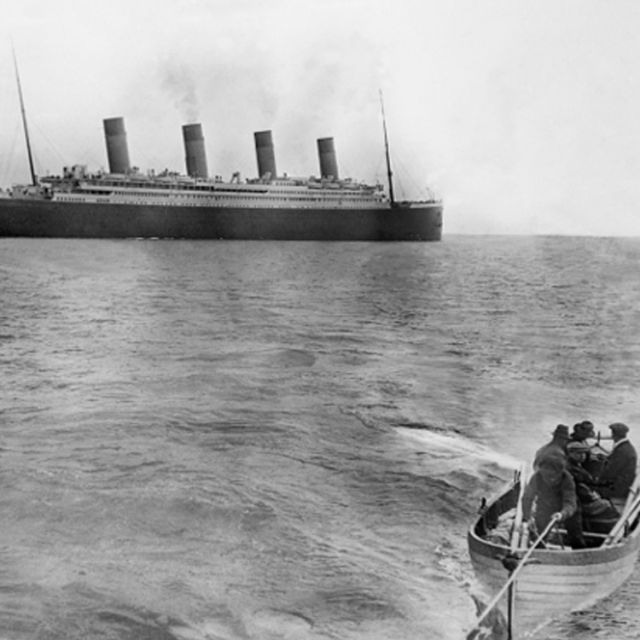Brown died in 1960 after earning a reputation as a gifted photographer. As a 21-year old Jesuit scholastic, he had received a first-class ticket on the Titanic from his uncle, the bishop of Cloyne. He boarded the ship as it took off from Southampton, England, then stopped at Cherbourg, France, and Queenstown, Ireland, the final European stop before the Titanic was to head for America.
At each of these stops some passengers disembarked and others boarded. Browne never intended to cross the Atlantic. He made the early part of the maiden voyage and left the ship permanently in Queenstown to go on a bicycle tour of Ireland with friends.
An amateur photographer who carried his own portable dark room, Browne documented the activities on board during his days as a passenger. He used a Kodak camera to photograph most parts of the ship — the giant boilers, exercise room, first- second-and third-class staterooms and dining and social areas. He took the only photo ever seen of the captain on board the Titanic as he inspected lifeboats. (Tragically, there were insufficient lifeboats to accommodate all the passengers and crew.)
Browne was also fascinated with wireless operations and took many photos of the Marconi wireless room and the operators. He photographed guests temporarily leaving the ship in Queenstown to buy Irish lace from women in stalls on the dock. Lord Astor is shown strutting with his cane, his wife advanced in her pregnancy. Another photo shows six-year-old Robert Sedden from New York spinning a top on board.
During his short time on board, Browne may have spent time with Fr. Thomas Byles, who also boarded at Southampton en route to New York to officiate at a nephew’s wedding. Byles celebrated the last Catholic Mass on board in the second-class passenger lounge the day before the accident. His homily advised passengers to “have a lifeboat in the shape of a religious connection at hand in case of spiritual shipwreck.” At 2:15, as the ship was sinking, Byles administered confession for passengers on the front deck.
As Browne left the Titanic in Ireland, little did he realize his would be the only photographic record of the ship’s first and last voyage.
In the months after the Titanic sank, he gave lectures across Ireland, showing many of the photos. They were displayed on cream-coloured mount board with his handwritten notes. A photo of the stern of the ship as it left Ireland is the last existing photograph of the Titanic. The ship departed four hours late, causing many to wonder if the Titanic might have avoided the iceberg if the ship had left on time.
During his lecture circuit, Browne received a letter from Star Line, the ship’s owner, requesting: “We would appreciate if any lectures you deliver, you will refrain from any reference to the Titanic, as you understand we don’t wish the memory of this calamity should be perpetuated.”
Browne stopped his Titanic lectures and attended to his teaching duties and ordination in 1915. He continued his photographic avocation until the end of his life and is recognized today as one of Ireland’s greatest photographers of the first half of the 20th century. He was deemed to be such a gifted photographer that the British head of Kodak Camera gave him a gift of a lifetime supply of Kodak film.
When Browne died, his trunk full of photographs and negatives was deposited in the Irish Jesuit Archives in Dublin. There they lay undiscovered for 25 years.
(Williams is a freelance writer in Markham, Ont.)
Jesuit priest’s photos last of doomed Titanic
By Lorraine Williams, Catholic Register SpecialApril 15 marks the 100th anniversary of the sinking of the Titanic. On that date the four-city-blocks-long ship, deemed unsinkable, hit an iceberg and in less than 2 1/2 hours sank to the bottom of the Atlantic Ocean. Of the 2,208 passengers, only 712 were rescued. The others perished in the icy north Atlantic.
For many years after, as far as anyone knew, no photos survived of those first carefree days at sea. Then in 1985, a Jesuit priest came across an old trunk in the basement of the Irish Jesuit Provincial House in Dublin, Ireland. It contained a stunning collection of photographs of the Titanic’s tragic maiden voyage that were taken by a future Jesuit priest named Francis Browne.
Today, a special room at the remarkable Titanic Ship Museum in Pigeon Forge, Tennessee, has devoted an entire room to enlargements of Browne’s original pictures — the only surviving record of life aboard that iconic ship. The exhibit is unforgettable.
Please support The Catholic Register
Unlike many media companies, The Catholic Register has never charged readers for access to the news and information on our website. We want to keep our award-winning journalism as widely available as possible. But we need your help.
For more than 125 years, The Register has been a trusted source of faith-based journalism. By making even a small donation you help ensure our future as an important voice in the Catholic Church. If you support the mission of Catholic journalism, please donate today. Thank you.
DONATE

